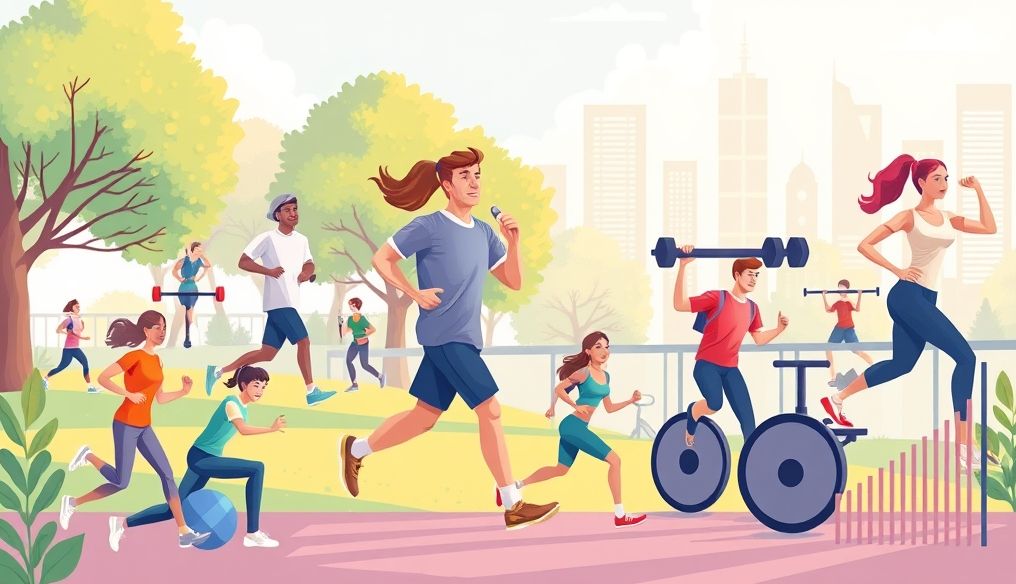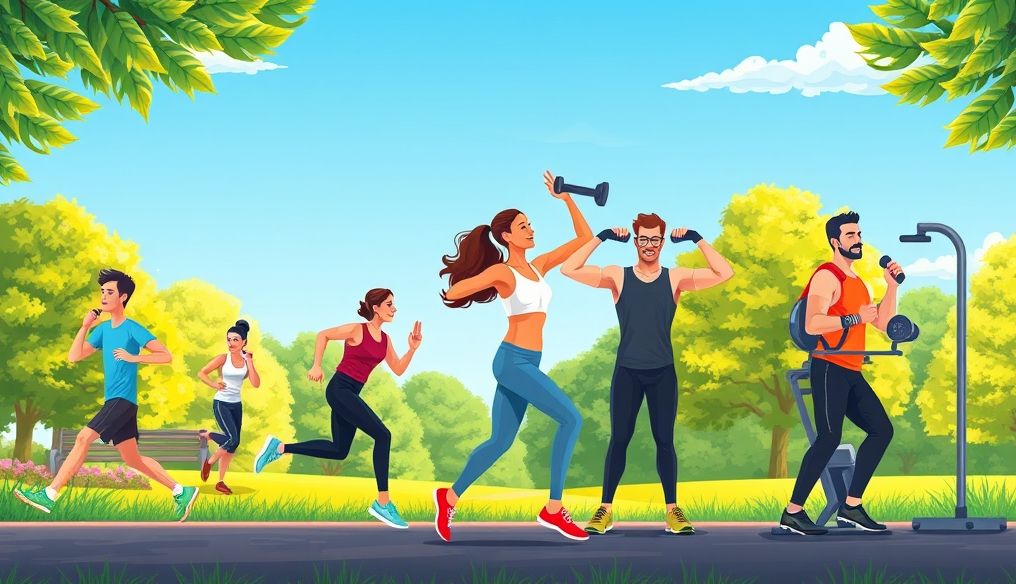What is the Relationship Between Physical Exercise and Mental Fitness, and How Can They Be Improved Together?
Physical health has long been associated with mental health, but what is the precise relationship between physical exercise and mental fitness? And how can we leverage this relationship to improve our overall health? This is what we will explore in detail in this article.
Chapter 1: Physiological Effects of Physical Exercise on the Brain
Physical exercise is not just an activity to improve body shape or increase muscle strength. It is also a powerful stimulant for the brain, affecting several important physiological processes:
Increased Blood Flow to the Brain
During exercise, the heart rate increases, leading to increased blood flow to the brain. This increased flow carries oxygen and essential nutrients to brain cells, improving their function and protecting them from damage.
Stimulation of Neurotrophic Factor Production
Physical exercise stimulates the production of neurotrophic factors, which are proteins that support the growth, development, and survival of nerve cells. One of the most important of these factors is brain-derived neurotrophic factor (BDNF), which acts as a "fertilizer" for the brain, improving memory, learning, and mood.
Reduction of Inflammation
Chronic inflammation can damage the brain and increase the risk of neurological diseases. Physical exercise helps reduce inflammation in the body, thereby protecting the brain.
Chapter 2: Cognitive Benefits of Physical Exercise
Thanks to the physiological effects mentioned above, physical exercise offers a wide range of cognitive benefits:
Improved Memory and Learning
Numerous studies have shown that regular exercise improves memory and learning, especially working memory and long-term memory. This means that exercise can help you remember information better and learn new skills more easily.
Increased Focus and Attention
Physical exercise helps improve focus and attention, and reduce distraction. This can be particularly beneficial for people with attention deficit hyperactivity disorder (ADHD).
Improved Executive Function
Executive functions are a set of mental processes that allow us to plan, make decisions, solve problems, and organize our behavior. Physical exercise improves these functions, making us more efficient and effective in our daily lives.
Reduced Risk of Neurological Diseases
Research suggests that regular exercise can reduce the risk of neurological diseases such as Alzheimer's disease and Parkinson's disease. This may be due to the effect of exercise on neurotrophic factors, reducing inflammation, and protecting brain cells.
Chapter 3: Impact of Physical Exercise on Mental Health
The benefits of physical exercise are not limited to cognitive aspects but also extend to mental health:
Reduced Stress and Anxiety
Physical exercise is an effective way to reduce stress and anxiety. During exercise, the body releases endorphins, which act as a natural pain reliever and improve mood.
Combating Depression
Studies have shown that physical exercise can be as effective as antidepressants in treating mild to moderate depression. Exercise helps increase levels of serotonin, dopamine, and norepinephrine, which are chemicals in the brain that play an important role in regulating mood.
Improved Self-Esteem
Regular exercise can improve your self-image and self-confidence. When you feel better about your appearance and physical abilities, it positively affects how you feel about yourself.
Improved Sleep Quality
Physical exercise can improve sleep quality, helping you feel rested and refreshed. However, strenuous exercise should be avoided immediately before bedtime, as it may make it difficult to sleep.
Chapter 4: Best Types of Physical Exercise for the Brain
All types of physical exercise are beneficial for the brain, but some types may be more effective than others:
Cardio
Cardio includes walking, running, swimming, cycling, and dancing. These exercises increase heart rate and blood flow to the brain, improving cognitive functions and mood.
Strength Training
Strength training includes lifting weights, using resistance machines, and bodyweight exercises. These exercises help build muscle and strengthen bones, but they are also beneficial for the brain, improving memory and focus.
Balance Exercises
Balance exercises include yoga, tai chi, and Pilates. These exercises improve balance and coordination, but they are also beneficial for the brain, improving executive functions and spatial memory.
Multitasking Exercises
Multitasking exercises include activities that require thinking, focusing, and coordinating, such as dancing, learning a new language, or playing a musical instrument. These activities stimulate the brain and help build new neural connections.
Chapter 5: How to Incorporate Physical Exercise into Your Daily Routine
It is not necessary to spend hours in the gym to get the benefits of physical exercise. Even simple activities can make a big difference:
Walking
Try to walk for at least 30 minutes most days of the week. You can walk while listening to music or podcasts, or walk with a friend or family member.
Climbing Stairs
Replace the elevator with the stairs whenever possible. Climbing stairs is an excellent exercise for the cardiovascular system and muscles.
Dancing
Dancing is a fun way to burn calories and improve your mood. You can dance at home or join dance classes.
Gardening
Gardening is an enjoyable and beneficial physical activity. You can plant flowers, vegetables, or herbs, or simply mow the lawn or remove weeds.
Exercising While Watching TV
You can do some simple exercises while watching TV, such as lifting light weights, stretching, or walking in place.
Chapter 6: Tips for Staying Motivated to Exercise
It can be difficult to stay motivated to exercise in the long run. Here are some tips that may help you:
Set Realistic Goals
Start with small, achievable goals, then gradually increase the difficulty of the exercises. Do not try to do too much too quickly, as this may lead to frustration and injury.
Find an Activity You Enjoy
If you do not enjoy the exercise you are doing, you are unlikely to stick with it in the long run. Try different types of exercises until you find something you enjoy.
Exercise with a Friend
Exercising with a friend can make it more fun and motivating. You can encourage each other and hold each other accountable.
Reward Yourself
Reward yourself when you achieve your fitness goals. You can buy new sportswear, go to the cinema, or have a delicious healthy meal.
Be Patient
Do not expect to see immediate results. It may take a few weeks or months to see noticeable improvements in your physical and mental health. Be patient and persistent, and you will eventually get the results you want.
Chapter 7: Proper Nutrition to Support Physical and Mental Fitness
You cannot maximize the benefits of physical exercise without following a healthy and balanced diet. Here are some nutritional tips to support physical and mental fitness:
Eat Plenty of Fruits and Vegetables
Fruits and vegetables are rich in vitamins, minerals, and antioxidants, which protect the brain from damage and enhance its functions.
Eat Enough Protein
Protein is essential for building and repairing muscles. Good sources of protein include meat, poultry, fish, eggs, legumes, nuts, and seeds.
Eat Healthy Fats
Healthy fats are essential for brain and heart health. Good sources of healthy fats include fatty fish, avocados, nuts, seeds, and olive oil.
Avoid Processed and Sugary Foods
Processed and sugary foods can harm the brain and increase the risk of chronic diseases.
Drink Plenty of Water
Water is essential for all bodily functions, including brain functions. Try to drink at least 8 glasses of water per day.
Chapter 8: Real-Life Examples and Success Stories
There are many real-life examples and success stories that prove the strong relationship between physical exercise and mental fitness:
Scientific Studies
Numerous scientific studies have shown that regular exercise improves memory, focus, and mood, and reduces the risk of neurological diseases.
Personal Stories
There are many people who have been able to improve their physical and mental health through regular exercise. For example, there are people who have been able to overcome depression and anxiety through exercise, and there are people who have been able to improve their memory and focus through exercise.
Rehabilitation Programs
Physical exercise is widely used in rehabilitation programs for people with brain injuries or neurological diseases. Physical exercise helps restore brain functions and improve quality of life.
Chapter 9: Conclusion and Recommendations
In conclusion, the relationship between physical exercise and mental fitness is strong and scientifically proven. Regular exercise not only benefits your body but also enhances your mental abilities, improves your mood, and reduces your risk of neurological diseases. So, make exercise an essential part of your daily routine, and enjoy its many health benefits.
Recommendations:
- Exercise for at least 30 minutes most days of the week.
- Choose the type of exercise you enjoy.
- Set realistic goals.
- Exercise with a friend.
- Reward yourself when you achieve your fitness goals.
- Follow a healthy and balanced diet.
- Be patient and persistent.
Wishing you good health and a sound mind!




